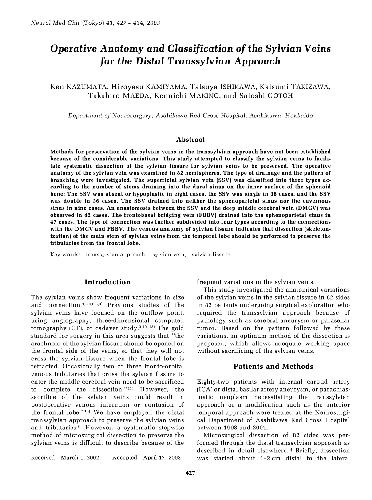Ken KAZUMATA, Hiroyasu KAMIYAMA
Methods for preservation of the sylvian veins in the transsylvian approach have not been established because of the considerable variations. This study attempted to classify the sylvian veins to facilitate systematic dissection of the sylvian fissure for sylvian veins to be preserved. The operative anatomy of the sylvian vein was examined in 82 hemispheres. The type of drainage and the pattern of branching were investigated. The superficial sylvian vein (SSV) was classified into three types according to the number of stems draining into the dural sinus on the inner surface of the sphenoid bone: The SSV was absent or hypoplastic in eight cases, the SSV was single in 38 cases, and the SSV was double in 36 cases. The SSV drained into neither the sphenoparietal sinus nor the avernous sinus in nine cases. An anastomosis between the SSV and the deep middle cerebral vein (DMCV) was observed in 42 cases. The frontobasal bridging vein (FBBV) drained into the sphenoparietal sinus in 47 cases. The type of connection was further subdivided into four types according to the connections with the DMCV and FBBV. The venous anatomy of sylvian fissure indicates that dissection (skeletonization) of the main stem of sylvian veins from the temporal lobe should be performed to preserve the tributaries from the frontal lobe. | |







Reviews
There are no reviews yet.